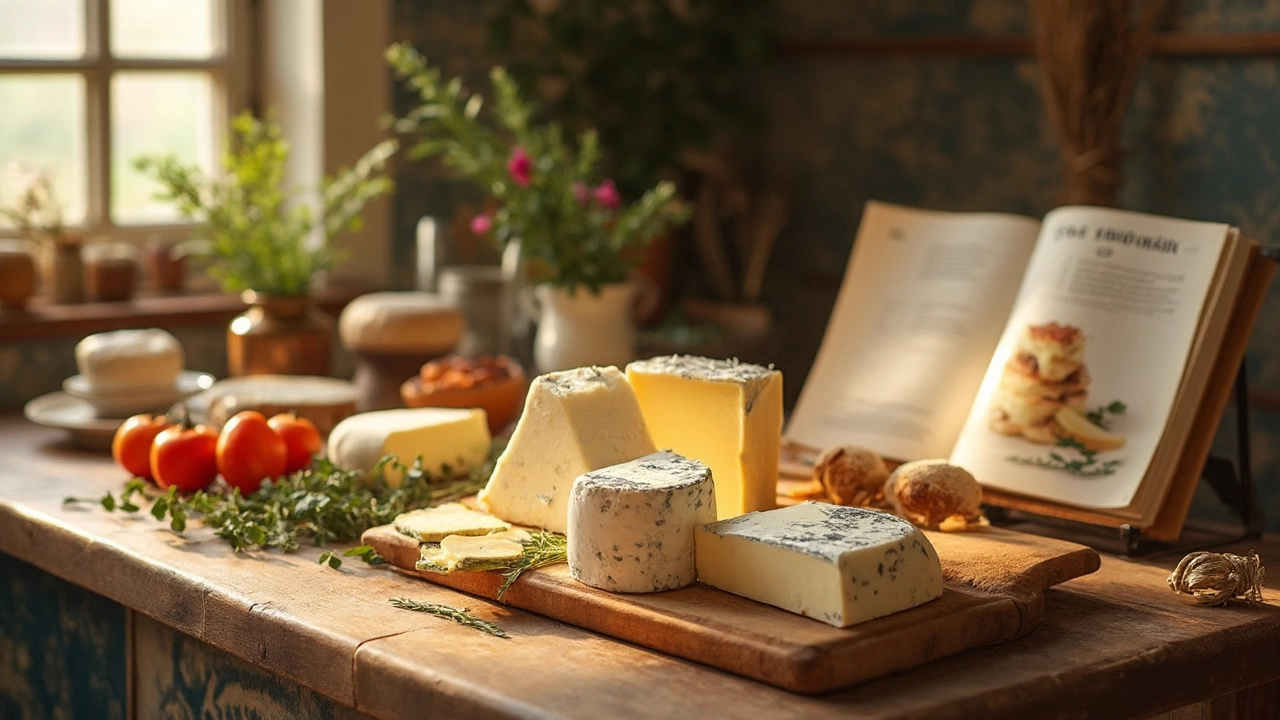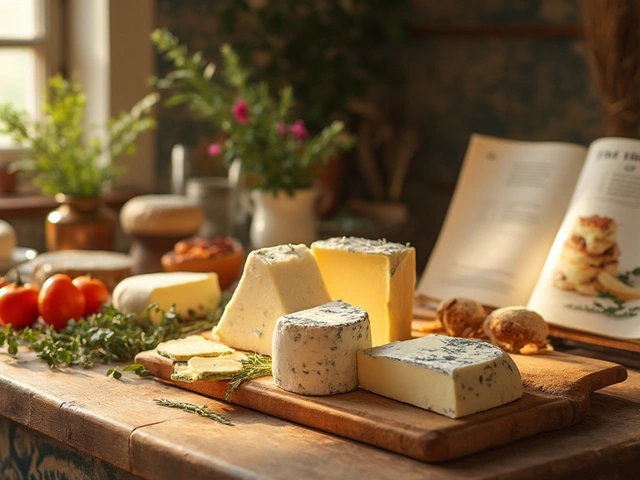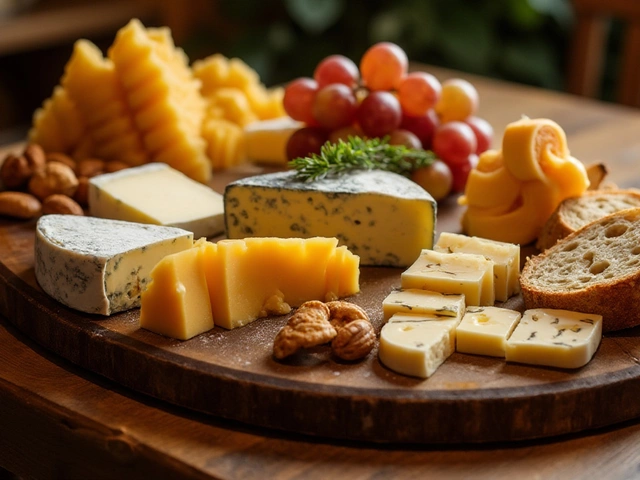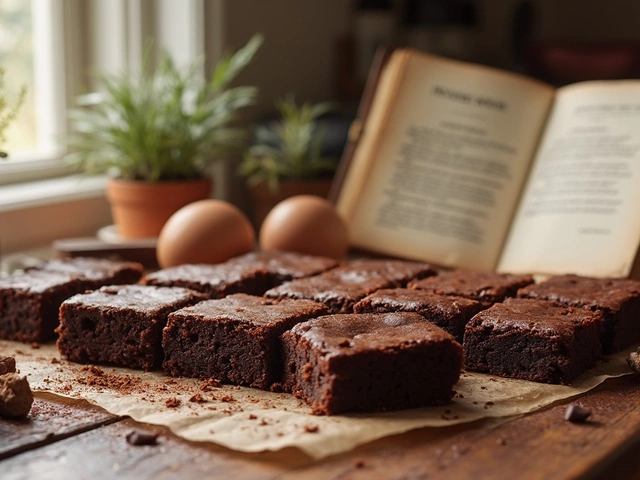
We all love cheese, right? But let's face it, figuring out which cheese has more fat can be a bit of a puzzle. Today, we're diving into the creamy world of mozzarella and prato cheese to see which one packs more of a fatty punch.
Mozzarella is often praised for its stretchy, melty goodness, especially on pizzas and pastas. But what's the story behind its fat content? Surprisingly, it's not as high-fat as you might think, especially if you opt for the part-skim variety.
On the flip side, there's prato cheese, which is a beloved choice in many sandwich spots. It might not be as globally famous as mozzarella, but its rich taste certainly makes up for it. So where does prato stand in the fat department? Turns out, it's generally higher in fat compared to mozzarella, making it a more indulgent choice.
- Understanding Mozzarella Cheese
- Getting to Know Prato Cheese
- Comparing Fat Content
- Nutritional Profiles at a Glance
- Practical Tips for Healthier Choices
- Crafting Tiramisu with Creamy Cheeses
Understanding Mozzarella Cheese
Ah, mozzarella, the cheese that makes any pizza lover’s heart skip a beat. Known for its soft texture and mild flavor, it's a staple in countless dishes. But what's the scoop behind this delicious dairy delight? Let’s break it down.
The Origin Story
Originating from Italy, mozzarella is traditionally made from the milk of water buffaloes. However, nowadays most of the mozzarella found in stores is made from cow's milk. This cheese falls under the category of pasta filata, where the curds are heated and stretched to create its distinct stringy texture. Fascinating, huh?Mozzarella Types
When you wander down the cheese aisle, you might notice several variants of mozzarella. There’s fresh mozzarella, which comes in a liquid bath and offers a higher moisture content with a super creamy texture. Then, there's low-moisture mozzarella, typically used for pizzas due to its excellent meltability. And let’s not forget the choice between whole milk and part-skim versions, where the latter contains less fat.Breaking Down the Fat Content
So how does its fat stack up? Fresh mozzarella generally contains about 6 grams of fat per ounce, while part-skim varieties can be slightly lower. It’s generally lower in fat compared to our friend, prato cheese, especially if you choose wisely. When you're on a cheese diet (which isn't **really** a thing), going part-skim is usually the better option.Nutritional Extras
Aside from fat, mozzarella packs a punch in the protein department, offering about 7-8 grams per ounce. It's also a decent source of calcium, which is great for your bones, and it contains less sodium than many other cheeses. Keep an eye out for that high moisture content, though; it could make or break your culinary masterpieces!Whether enjoying it on your Margherita pizza or layered in a caprese salad, understanding mozzarella helps you savor each delicious bite—without all the guilt!
Getting to Know Prato Cheese
So, what's the scoop on prato cheese? If you’re in Brazil, you’ve probably seen this cheese a lot. It's a staple in many households, and for good reason. Prato cheese has a rich history dating back to the 1920s when it was first made by Danish immigrants in Minas Gerais, Brazil. They aimed to create something similar to the Dutch Edam cheese but with a local twist.
Prato cheese is semi-hard and comes in a pale yellow hue, characterized by its creamy and buttery flavor. It's typically aged for about 20 to 25 days which gives it that distinct mellow yet tangy taste. Perfect for sandwiches, it melts wonderfully, making it a go-to for grilled cheese and burgers.
Nutrition-wise, prato cheese is higher in fat compared to some other cheeses. A 100-gram serving can pack about 30 grams of fat, and that's something to consider if you're watching your intake.
How to Use Prato Cheese
Thinking of adding prato cheese to your meals? Here are some popular ways to use it:
- Breakfast sandwiches: Melt it over a warm croissant or inside a toasted baguette for a delicious start to your day.
- Cheese boards: Pair it with fruits like grapes and apples to balance its rich flavor.
- Baked dishes: Use it as a topping for casseroles or pasta bakes. The creamy melt adds a lovely texture.
| Nutritional Element | Amount per 100g |
|---|---|
| Calories | 352 |
| Fat | 30g |
| Protein | 22g |
| Carbohydrate | 1g |
Whether you're cooking or just snacking, prato cheese brings a slice of Brazilian tradition to the table. And if you're ever in doubt about putting it into a dish, remember its mild taste makes it versatile enough to complement a variety of flavors without overpowering them.
Comparing Fat Content
When it comes to cheese, fat content can vary a lot, and it’s something cheese lovers should keep an eye on. Let's dig into how mozzarella and prato cheese stack up against each other.
Mozzarella Cheese
Mozzarella is often considered the friendlier option for anyone watching their waistline. The regular whole milk mozzarella usually contains around 6-8 grams of fat per ounce. If you choose the part-skim version, you're looking at about 4.5 grams of fat per ounce—so there’s a bit of room to maneuver if you’re cutting down fat.
Prato Cheese
Prato cheese, on the other hand, is richer in flavor and fat. An average ounce packs about 9-11 grams of fat. It’s denser and more indulgent, which makes it a great choice when you’re looking for that extra creaminess in your dish. But if you're counting calories, it's something to be mindful of.
A Quick Comparison
| Cheese | Fat per Ounce (approx.) |
|---|---|
| Mozzarella (Whole Milk) | 6-8g |
| Mozzarella (Part-skim) | 4.5g |
| Prato | 9-11g |
Now that you know the numbers, it makes managing your meal choices a bit easier, doesn’t it? While both cheeses have their unique charms, choosing the right one depends on what you're aiming for—whether it’s keeping things light or indulging a bit. Whatever your choice, enjoy it knowing you're making an informed decision.

Nutritional Profiles at a Glance
Alright, let's get into the nitty-gritty of comparing the nutritional aspects of mozzarella and prato cheese. Understanding these profiles can help you decide the best choice for your diet and taste preferences.
Mozzarella Facts
First up, mozzarella. Whether it's made from cow's milk or the exclusive buffalo milk version, this cheese tends to be lower in fat if you go for the part-skim variety. It's also a good source of calcium and protein, making it pretty decent on the nutritional front.
Here’s a quick look at part-skim mozzarella per 100 grams:
- Calories: Around 280
- Total Fat: Approximately 17g
- Protein: Roughly 28g
- Calcium: Provides about 50% of daily intake
Prato Cheese Breakdown
Prato cheese is creamier and richer, and unsurprisingly, it has more fat content compared to mozzarella. This added richness makes it a perfect candidate for indulgent dishes.
Here's what 100 grams of prato cheese packs in:
- Calories: About 350
- Total Fat: Around 28g
- Protein: Approximately 22g
- Calcium: Offers about 45% of daily intake
Comparative Overview
If you're looking at these two with fat content in mind, mozzarella might get the thumbs up for lower total fat, especially if you stick with part-skim versions. On the other hand, if you're crafting a rich and creamy dish, the full-bodied nature of prato cheese could elevate your culinary creation.
Remember, moderation is key when it comes to cheese consumption. Whether it's mozzarella or prato, both have their place in a balanced diet. Let your taste buds and dietary needs guide your cheese choices!
Practical Tips for Healthier Choices
Eating cheese is one of life's simple pleasures, but keeping an eye on fat content is important too. If you're torn between mozzarella and prato cheese, here are some handy tips to keep things lighter without losing taste.
Choose Low-Fat Varieties
Believe it or not, many cheese producers offer low-fat options that still taste great. For mozzarella, the part-skim version is a go-to. It's lower in fat than its whole milk counterpart and still melts beautifully.
Portion Control is Key
It sounds basic, but measuring your portions can really help. Stick to one or two ounces of cheese per serving. That way, you still enjoy the richness without going overboard.
Balance with Other Ingredients
Pair your cheese with low-fat or high-fiber sides. Fresh veggies, whole grain crackers, or a slice of multigrain bread can make a cheese plate feel balanced. It’s all about enjoying your favorite flavors in moderation.
"Many recipes can be adjusted to healthier standards without losing the essence of the dish." - Jamie Oliver, Chef and Cookbook Author
Consider Plant-Based Cheeses
If you're open to alternatives, plant-based cheeses are popping up everywhere. They can be lower in fat and might surprise you with their flavor. Just make sure to check the labels as some brands add more additives.
| Cheese | Average Fat Content (per 100g) |
|---|---|
| Mozzarella (Part-Skim) | 15g |
| Prato | 26g |
By being mindful of the type and amount of cheese you consume, you can enjoy all that gooey or creamy goodness with less guilt.
Crafting Tiramisu with Creamy Cheeses
Who doesn't love a good tiramisu? Let's talk about using mozzarella and prato cheese in this classic dessert, although it might sound a bit unusual. Traditional tiramisu is all about mascarpone, but if you're experimenting or simply out of mascarpone, you might wonder if other cheeses could step in.
First things first, the idea of using mozzarella in tiramisu may raise some eyebrows, but let's consider softer options like burrata, which belongs to the mozzarella family. It won't give you that same creamy richness as mascarpone, but it can work for a lighter version, especially if you're targeting a lower-fat alternative. Just make sure it's well-drained to avoid a watery mess.
As for prato cheese, it isn't the go-to for tiramisu because of its stronger flavor compared to mascarpone's mild and creamy profile. Yet, in a fusion-style tiramisu, you could play around with it, especially if you appreciate a bit of a savory twist.
Practical Tips for Cheese Substitutes in Tiramisu
- Always taste your cheese first to judge its suitability. If it's too sharp, it might overpower the dessert.
- Blend your chosen cheese with some cream or even whipped cream to reach the desired texture without veering off the original tiramisu feel.
- If aiming for a different spin on the classic, pair your substitute cheese with complementary flavors like coffee or cocoa to balance it out.
Remember, creativity is key here. Whether aiming to cut down on fat or just explore new flavors, using mozzarella or prato cheese can result in exciting tiramisu variations that you're unlikely to find anywhere else.










Write a comment